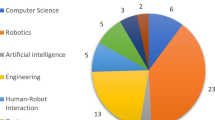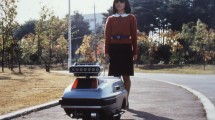Abstract
Robotic systems and technologies step out of research laboratories jointly with information about long-term goals of technological inquiry they are lined up with and about the short-term objectives guiding daily laboratory activities. These various ingredients play crucial roles in the pursuit of what are called here technological research programs. A comprehensive ethical framing of technological research programs is decomposed here into the ethical framing of their long-term and short-term goals, respectively. This approach to the ethical framing of technological research is exemplified by reference to fundamental rights in the context of technological research programs on elderly care and child care robots. Moreover, its significance is highlighted in connection with democratic decision-making about new and emerging technologies, as well as in connection with the cultural production of ignorance which is induced by missing information about the protection and promotion of fundamental rights in the specific context of robotic technologies.
Similar content being viewed by others
Notes
This paper is based on my presentation at the International Conference Going beyond the laboratory: ethical and societal challenges for robotics organized by Universität Oldenburg and held on February 13–15, 2014, at the Hanse Wissenschaftkolleg in Delmenhorst, Germany. My presentation there benefited from previous discussions of technological research programs with Roberto Cordeschi.
See http://www.robocup.org/about-robocup/objective/. This Webpage and every other Webpage referred to in this article were last visited on February 10, 2015. Here is the full quote: “Needless to say, the accomplishment of the ultimate goal will take decades of efforts, if not centuries. It is not feasible, with the current technologies, to accomplish this goal in any near term. However, this goal can easily create a series of well-directed subgoals. Such an approach is common in any ambitious, or overly ambitious, project.”
The wide range of application areas can be gleaned from The Handbook of Robotics (Siciliano and Khatib 2009) whose table of contents covers a wide variety of application domains (such as industrial and agricultural robotics, underwater, space and aerial robotics, search and rescue robotics, medical and rehabilitation robotics, and edutainment and social robotics) and activities that robots engage into (such as sensing and perceiving, moving, reasoning, and planning).
See again the Webpage http://www.robocup.org/about-robocup/objective/.
See www.robocupathome.org. RoboCup-Rescue is a friendly competition which aims at developing robotic systems working in multi-agent teams for search and rescue in earthquake-stricken and other disaster areas (www.robocuprescue.org). Competitive challenges have been a source of technological advancement in many different areas of technological inquiry. In robotics, another significant case in point is the DARPA Robotic Challenge, driven by the long-term goal of building autonomous robotic systems which enable one to replace human operators in dangerous task environments. The DARPA Robotic Challenge accommodates periodic competitions between robots for task-level autonomy and operational capabilities in a variety of hazardous trial arenas. See www.darpa.mil/Our_Work/TTO/Programs/DARPA_Robotics_Challenge.aspx. The automobile industry affords, with its various categories of formula racing competitions, another popular example of competition-driven technological research and innovation.
References
Ainsworth MD, Blehar M, Waters E, Wall S (1978) Patterns of attachment: a psychological study of the strange situation. Lawrence Erlbaum Associates, Hillsdale
Asada M, Kitano H, Noda I, Veloso M (1999) RoboCup: today and tomorrow—what we have learned. Artif Intell 110:193–214
Bowlby J (1969–1980) Attachment and loss. Hogarth, London
Camporesi F (2011) The European Parliament and the EU charter of fundamental rights. In: Di Federico G (ed) The EU charter of fundamental rights: from declaration to binding instrument. Springer, Dordrecht, pp 77–94
Christman J (2015) Autonomy in moral and political philosophy. Stanford encyclopedia of philosophy. Retrieved on June 9th, 2015 from http://plato.stanford.edu/entries/autonomy-moral/
Cohen J, Arato A (1992) Politics and the reconstruction of the civil society. In: Honneth A, McCarthy Th, Offe C, Wellmer A (eds) Cultural-political interventions in the unfinished project of enlightenment. MIT Press, Cambridge, pp 121–144
Cooley M (2009) On human-machine symbiosis. In: Gill S (ed) Cognition, communication, and interaction. Springer, London, pp 457–485
Datteri E, Tamburrini G (2013) Robotic weapons and democratic decision-making. In: Hilgendorf E, Günther J-P (eds) Robotik und Gesetzegebung. Nomos Verlag, Baden-Baden, pp 211–230
Diamond J (2013) The world until yesterday. Penguin, London
Eibl-Eibesfeldt I (1989) Human ethology. Aldine de Gruyter, New York
Ertel KA, Glymour MM, Berkman LF (2008) Effects of social integration on preserving memory function in a nationally representative US elderly population. Am J Public Health 9:1215–1220
European Union (2000) The EU charter of fundamental rights. Retrieved on June 9th, 2015 from http://ec.europa.eu/justice/fundamental-rights/charter/index_en.htm
Farah M (2002) Emerging ethical issues in neuroscience. Nat Neurosci 5:1123–1129
Feil-Seifer D, Mataric MJ (2010) Dry your eyes: examining the roles of robots for childcare applications. Interact Stud 11:208–213
Gabel T, Riedmiller M (2010) On progress in RoboCup: the simulation league showcase. In: Chown E, Plöger PG (eds) RoboCup 2010: Robot Soccer World Cup XIV, LNCS. Springer, Singapore
Galison P (1997) Image and logic: a material culture of microphysics. University of Chicago Press, Chicago
Godfrey-Smith P (2003) Theory and reality: an introduction to the philosophy of science. University of Chicago Press, Chicago
Kitano H, Kuniyoshi Y, Noda I, Asada M, Matsubara H, Osawa E (1997) RoboCup: a challenge problem for AI. AI Mag 18:73–85
Lakatos I (1978) Falsification and the methodology of scientific research programmes. In: Worrall J, Currie G (eds) Philosophical papers: the methodology of scientific research programmes, vol 1. Cambridge University Press, Cambridge
Laudan L (1977) Progress and its problems: toward a theory of scientific growth. University of California Press, Berkeley
MacIntyre A (1999) Dependent rational animals: why human beings need the virtues. Open Court, Chicago
Mackenzie C (2008) Relational autonomy, normative authority and perfectionism. J Soc Philos 39:512–533
Nordmann A (2007) If and then: a critique of speculative nanoethics. Nanoethics 1:31–46
Prescott TJ (2013) Sunny uplands or slippery slopes? The risks and benefits of using robots in care. In: UKRE workshop on robot ethics, 25 March 2013, Sheffield, UK. Retrieved on June 9th, 2015 from http://www.abrg.group.shef.ac.uk/pubs/?year=2013
Proctor R (2008) A missing term to describe the cultural production of ignorance (and its study). In: Proctor R, Schiebinger L (eds) Agnotology: the making and unmaking of ignorance. Stanford University Press, Stanford, pp 1–33
Russell S, Norvig P (2010) Artificial intelligence: a modern approach, 3rd edn. Prentice Hall, New York
Scalzone F, Tamburrini G (2013) Human–robot interaction and psychoanalysis. AI Soc 28:297–307
Scheutz M (2011) The inherent dangers of unidirectional emotional bonds between humans and social robots. In: Lin P, Abney K, Bekey G (eds) Robot ethics: the ethical and social implications of robotics. MIT Press, Cambridge, pp 205–222
Schore AN (2010) Attachment trauma and the developing right brain: origins of pathological dissociation. In: Dell PF, O’Neil JA (eds) Dissociation and the dissociative disorders: DSM-V and beyond. Routledge, New York, pp 107–143
Seidensticker B (2006) Future hype: the myths of technology change. Berrett-Koehler Pub, San Francisco
Sharkey A, Sharkey N (2010) The crying shame of robot nannies: an ethical appraisal. Interact Stud 11:161–190
Sharkey A, Sharkey N (2011) Children, the elderly, and interactive robots. IEEE Robot Autom Mag 18(1):32–38
Siciliano B, Khatib O (eds) (2009) Handbook of robotics. Springer, Berlin
Sparrow R, Sparrow L (2006) In the hands of machines? The future of aged care. Minds Mach 16:141–161
Tamburrini G (2009) Brain to computer communication: ethical perspectives on interaction models. Neuroethics 2:137–142
United Nations (1948) The universal declaration of human rights. Retrieved on June 9th, 2015 from http://www.un.org/en/documents/udhr/
United Nations (1989) The convention on the rights of the child. Retrieved on June 9th, 2015 from http://www.unicef.org.uk/UNICEFs-Work/UN-Convention/
van Lente H, Spitters C, Peine A (2013) Comparing technological hype cycles: towards a theory. Technol Forecast Soc Change 80:1615–1628
Visser U, Burkhard H-D (2007) RoboCup: ten years of achievements and future challenges. AI Mag 28:115–132
Acknowledgments
Stimulating comments by Thomas Christaller, Edoardo Datteri, Michael Nagenborg, Leen Spruit, and an anonymous reviewer are gratefully acknowledged.
Author information
Authors and Affiliations
Corresponding author
Rights and permissions
About this article
Cite this article
Tamburrini, G. On the ethical framing of research programs in robotics. AI & Soc 31, 463–471 (2016). https://doi.org/10.1007/s00146-015-0627-2
Received:
Accepted:
Published:
Issue Date:
DOI: https://doi.org/10.1007/s00146-015-0627-2




